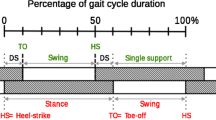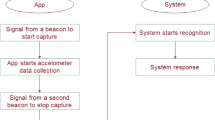Abstract
The existing algorithms for step detection have rarely been designed for walking in complex scenes. Complex scenes often bring about more complicated changes in walking states that could cause ordinary detection algorithms less effective. In this paper, an observation is made that there are gatherings of low-frequency signals, called clusters, in the spectrogram generated from the walking signal in a particular situation through wavelet transform. The clusters would exhibit prominent features when some specific basis function is chosen for the wavelet transform, which can precisely characterize the strides in walking. Then, the criteria for choosing the basis function of wavelet transform are established and verified experimentally. Based on the spectral features, an efficient and accurate step detection algorithm named frequency domain extension detection (FDED) is proposed and its time/space complexity will be no more than the constant times of its input size, O(n). FDED consists of three phases. First, the Kalman filter is adopted to denoise the raw data. Then, a continuous wavelet transform is applied to the filtered data to attain the obvious gait pattern in the time spectrum. Finally, a robust detection algorithm is proposed to implement step counting and single-stride segmentation. The experiments are conducted on two datasets, Diecui, a self-established dataset with diverse walking patterns in complex scenes, and a public dataset, ZJU-gaitacc. The experimental results show that FDED achieves an average accuracy of 99.1% for step counting on Diecui, and outperforms several representative detection algorithms on ZJU-gaitacc, which suggests that the proposed algorithm possesses strong adaptability in complex scenes with diverse personnel.










Similar content being viewed by others
Data availability
All raw data, during the study are available from the corresponding author by request.
References
Abadleh A, Al-Mahadeen BM, AlNaimat RM et al (2021) Noise segmentation for step detection and distance estimation using smartphone sensor data[J]. Wireless Netw 27:2337–2346
Addison PS, Watson JN, Feng T (2002) Low-oscillation complex wavelets[J]. J Sound Vib 254(4):733–762
Anwary AR, Yu H, Vassallo M (2018) Optimal foot location for placing wearable IMU sensors and automatic feature extraction for gait analysis. IEEE Sens J 2555–2567
Ates HC, Nguyen PQ, Gonzalez-Macia L et al (2022) End-to-end design of wearable sensors[J]. Nat Rev Mater 7(11):887–907
Avci A, Bosch S, Marin-Perianu M, Marin-Perianu R, Havinga PJM (2010) Activity recognition using inertial sensing for healthcare, wellbeing and sports applications: A survey. In 23th International conference on architecture of computing systems 2010 (pp 1–10), February
Bao L, Intille S (2004) Activity recognition from user-annotated acceleration data. Proc 2nd Int Conf Pervasive Comput pp 1–17
Barralon P, Vuillerme N, Noury N (2006) Walk detection with a kinematic sensor: frequency and wavelet comparison[C]. 2006 International Conference of the IEEE Engineering in Medicine and Biology Society. IEEE 1711–1714
Barth J, Oberndorfer C, Pasluosta C et al (2015) Stride segmentation during free walk movements using multi-dimensional subsequence dynamic time warping on inertial sensor data[J]. Sensors 15(3):6419–6440
Dehzangi O, Taherisadr M, ChangalVala R (2017) IMU-based gait recognition using convolutional neural networks and multi-sensor fusion[J]. Sensors 17(12):2735
Dwivedi P, Singha MK (2021) Iot based wearable healthcare system: post covid-19[J]. The Impact of the COVID-19 Pandemic on Green Societies: Environmental Sustainability 305–321
Fortino G, Galzarano S, Gravina R, Li W (2015) A framework for collaborative computing and multi-sensor data fusion in body sensor networks. Inf Fusion 22:50–70
Genovese V, Mannini A, Sabatini AM (2017) A Smartwatch step counter for slow and intermittent ambulation. IEEE Access 5:13028–13037
Giorgi G, Martinelli F, Saracino A et al (2017) Try walking in my shoes, if you can: Accurate gait recognition through deep learning[C]. Computer Safety, Reliability, and Security: SAFECOMP 2017 Workshops, ASSURE, DECSoS, SASSUR, TELERISE, and TIPS, Trento, Italy, September 12, 2017, Proceedings 36. Springer International Publishing 384–395
Harle R (2013) A survey of indoor inertial positioning systems for pedestrians[J]. IEEE Commun Surv Tutor 15(3):1281–1293
Heikenfeld J, Jajack A, Rogers J et al (2018) Wearable sensors: modalities, challenges, and prospects[J]. Lab Chip 18(2):217–248
Hölzke F, Heller J, Deatcu SA et al (2020) Step detection through ultra-low complexity zero crossing analysis[C]. 2020 15th IEEE International Conference on Signal Processing (ICSP). IEEE 1:626–631
Kadaba MP, Ramakrishnan HK, Wootten ME (1990) Measurement of lower extremity kinematics during level walking[J]. J Orthop Res 8(3):383–392
Kang J, Lee J, Eom DS (2018) Smartphone-based traveled distance estimation using individual walking patterns for indoor localization[J]. Sensors 18(9):3149
Ladetto Q (2000) On foot navigation: continuous step calibration using both complementary recursive prediction and adaptive Kalman filtering[C]. Proceedings of the 13th International Technical Meeting of the Satellite Division of The Institute of Navigation (ION GPS 2000). 1735–1740
Lin F, Wang A, Song C, Xu W et al (2015) A comparative study of smart insole on real-world step count[C]. 2015 IEEE Signal Processing in Medicine and Biology Symposium (SPMB). IEEE 1–6
Mallat S (1999) A wavelet tour of signal processing[M]. Elsevier
Mallat S, Hwang WL (1992) Singularity detection and processing with wavelets[J]. IEEE Trans Inf Theory 38(2):617–643
Marsico MD, Mecca A (2017) Biometric walk recognizer: gait recognition by a single smartphone accelerometer[J]. Multimed Tools Appl 76:4713–4745
Marsico MD, Mecca A (2019) A survey on gait recognition via wearable sensors[J]. ACM Computing Surveys (CSUR) 52(4):1–39
Mukhopadhyay SC, Suryadevara NK, Nag A (2022) Wearable sensors for healthcare: Fabrication to application[J]. Sensors 22(14):5137
Nasr A, Nadeem T (2019) A novel technique for gait analysis using two waist mounted gyroscopes[C]. 2019 IEEE Global Communications Conference (GLOBECOM). IEEE 1–6
Nyan MN, Tay FEH, Seah KHW, Sitoh YY (2006) Classification of gait patterns in the time–frequency domain[J]. J Biomech 39(14):2647–2656
Perc M (2005) The dynamics of human gait[J]. Eur J Phys 26(3):525
Pino-Ortega J, Gómez-Carmona CD, Rico-González M (2021) Accuracy of Xiaomi Mi Band 2.0, 3.0 and 4.0 to measure step count and distance for physical activity and healthcare in adults over 65 years[J]. Gait Posture 87:6–10
Qian J, Cheng Y, Ying R, Liu P (2020) A novel indoor localization method based on image retrieval and dead reckoning[J]. Appl Sci 10(11):3803
Sekine M, Tamura T, Akay M et al (2000) Analysis of acceleration signals using wavelet transform[J]. Methods Inf Med 39(02):183–185
Shukla PD (2003) Complex wavelet transforms and their applications[J]. A Dissertation Submitted of Signal Processing Division, Department of Electronic and Electrical Engineering University of Strathclyde Scotland United Kingdom
Soaz C, Diepold K (2016) Step detection and parameterization for gait assessment using a single waist-worn accelerometer. IEEE Trans Biomed Eng 63(5):933–942
Steinmetzer T, Bönninger I, Reckhardt M et al (2020) Comparison of algorithms and classifiers for stride detection using wearables[J]. Neural Comput Appl 32(24):17857–17868
Suksuganjana W, Laitrakun S, Athikulwongse K, Hara-Azumi Y, Deepaisarn S () Improved step detection with smartphone handheld mode recognition. 2021 13th International Conference on Knowledge and Smart Technology, 2021, pp 55–60
Taborri J, Palermo E, Rossi S, Cappa P (2016) Gait partitioning methods: a systematic review. Sensors 16(1):66
Tanigawa A, Morino S, Aoyama T, Takahashi M (2018) Gait analysis of pregnant patients with lumbopelvic pain using inertial sensor. Gait Posture 65:176–181
Tarnita D (2016) Wearable sensors used for human gait analysis[J]. Rom J Morphol Embryol 57(2):373–382
Wang JH, Ding JJ, Chen Y et al (2012) Real time accelerometer-based gait recognition using adaptive windowed wavelet transforms[C]. 2012 Ieee Asia pacific conference on circuits and systems. IEEE 591–594
Wang Z, Wu D, Gravina R, Fortino G, Jiang Y, Kai T (2017) Kernel fusion based extreme learning machine for cross-location activity recognition. Inf Fusion 37:1–9
Wu J, Wu B (2015) The novel quantitative technique for assessment of gait symmetry using advanced statistical learning algorithm[J]. BioMed Res Int 2015
Yao Y, Pan L, Fen W et al (2020) A robust step detection and stride length estimation for pedestrian dead reckoning using a smartphone[J]. IEEE Sens J 20(17):9685–9697
Zhang Y, Pan G, Jia K et al (2014) Accelerometer-based gait recognition by sparse representation of signature points with clusters[J]. IEEE Trans Cybern 45(9):1864–1875
Zhao H, Wang Z, Qiu S, Wang J, Xu F, Wang Z, Shen Y (2019) Adaptive gait detection based on foot-mounted inertial sensors and multi-sensor fusion. Inf Fusion 52:157–166
Zhao H, Wang Z, Qiu S et al (2019) Adaptive gait detection based on foot-mounted inertial sensors and multi-sensor fusion[J]. Inf Fusion 52:157–166
Zhang H, Huang TS, Nasrabadi NM, Zhang Y (2011) Heterogeneous multi-metric learning for multi-sensor fusion[C]. 14th International Conference on Information Fusion. IEEE 1–8
Zhao H, Su R, Teng L, Tian Q, Han F et al (2022) Recent advances in flexible and wearable sensors for monitoring chemical molecules[J]. Nanoscale 14(5):1653–1669
Author information
Authors and Affiliations
Corresponding author
Ethics declarations
Conflict of interest
The authors declare that there is no conflict of interests, and we do not have any possible conflicts of interest.
Additional information
Publisher's Note
Springer Nature remains neutral with regard to jurisdictional claims in published maps and institutional affiliations.
Rights and permissions
Springer Nature or its licensor (e.g. a society or other partner) holds exclusive rights to this article under a publishing agreement with the author(s) or other rightsholder(s); author self-archiving of the accepted manuscript version of this article is solely governed by the terms of such publishing agreement and applicable law.
About this article
Cite this article
Wu, X., Zeng, X., Lu, X. et al. Step detection in complex walking environments based on continuous wavelet transform. Multimed Tools Appl 83, 36603–36627 (2024). https://doi.org/10.1007/s11042-023-15426-6
Received:
Revised:
Accepted:
Published:
Issue Date:
DOI: https://doi.org/10.1007/s11042-023-15426-6




